The "BIG DIG" alias "EGGS FOR THE MASSES"
by Dick Bowman
Reprinted from "Crown Jewels of the Wire", May 1990, page 5
The threadless "Confederate Egg" (recently renumbered from CD 701
to CD 701.6) has long been regarded as a class act piece. Crudely made, with
nearly none identical and with a limited quantity known (probably no more than
15 in respectable condition prior to early 1990), it commanded a hefty price tag
and was highly sought.
If one could define "Insulator Heaven" it might
be something like digging an area where these prize eggs were coming up by the
score and your bucket was filling up with them too. This writer and a few other
Crown Jewels of the Wire subscribers were lucky enough to grab a bit of this
paradise. Granted, while some were broken and burned, others were in great
shape, never used, and to make it even more heavenly, in colors from various
shades of green, olive, blackglass, mottled green jade, milky aqua and to top it
off, cobalt blue, a previously unknown color in any egg. As Paul Harvey would
say -- "Here's the rest of the story..."
The stage was an area of
central Richmond, Virginia, near the banks of the James River in a rather
rundown warehouse section. The sound of traffic from I-95 about 400 yards away
could be heard. A steady stream of city traffic crossed the nearby May bridge
and the sounds of people and equipment associated with urban renewal and
reconstruction were everywhere. Several railroad tracks crossed nearby and the
heavy rumble of a freight train was frequently heard on the large steel bridge
that cast its shadow on the digging site. Under the bridge, smoke rose from a
fire in a old 55 gallon drum in an area where some of Richmond's less fortunate
gathered or made their home.
This plot of open land had apparently become a
focal point some months ago when a contractor dug the hole for a small structure
and hundreds of Civil War uniform buttons came to the surface or were later dug.
Since construction folks are always tuned to such things and there are a number
of pseudo Civil War relic diggers/collectors who follow nearly every piece of
earth-moving equipment they see, the area attracted a crowd and the booty was
gathered up.
The ground apparently lay fallow until early February, 1990, when a
backhoe dug a trench to lay a duct connecting two points on the site. Lo and
behold, at about the centerpoint of the trench emerged a number of crude,
strange looking objects. Scratching around quickly yielded more, soon identified
as threadless insulators. Some research done about this time indicated that this
was the site of a Confederate supply warehouse, known as the Mayo warehouse and
holding who knows what in addition to buttons and insulators. It seemed that
when Richmond was in imminent danger of being overrun by the Union forces in the
mid-1860's, the Confederated chose to leave nothing for them and at the same
time they burned the Mayo bridge, they also torched the brick and wood
warehouse. Since the area was prone to flooding the site was built up with fill
over the next 125 years, but likely in stages since a railroad spur 2-3 feet
below the surface was unearthed during the dig.
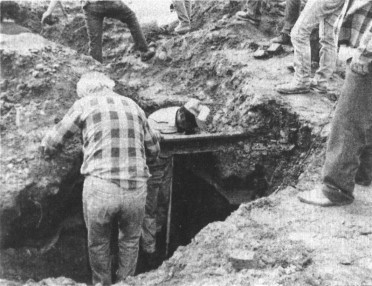
Diggers excavate beneath the rail of the buried railroad spur
approximately
2-3 feet below current ground level.
Back to the intrigue..... Many of the initial batches of eggs found their way into
local antique shops where contact was made with one or more insulator
collectors. Others made their way directly to a few collectors via old
friendships or past contacts with some of the diggers. The secret was now out
and the phones of the well-oiled and active "insulator network" were
jumping. One of the many phones calls during the ensuing week prompted Marshal
Dick's trusty steed to leave the driveway 1/2 hour later on an all night drive
to Richmond. A ride in Larry Veneziano's van with Larry and one of his friends
got us to the site early on February 19. By now, the site was fairly well known
in Richmond and all during the day, 20-25 people, both diggers and a changing
cast of observers were present. Even the crusty owner of a hardware store 4-5
blocks away where we bought shovels remarked, "You might as well dig
insulators too, everyone else is."

The Richmond "war zone " or "ant colony" crawling
with
Confederate relic hunters and insulator hounds.
The primary digging sites were contained in an area about 80 feet by 80 feet
centered around a large mound of dirt generated by the contractor. Six or seven
holes going as deep as 12 feet were in various stages of progress. Indeed, had
one viewed the site from far above, it would have looked like a cross between a
giant ant colony and a war zone. The first 8 to 9 feet down generally consisted
of rocks and dirt dumped over the years, then came a layer of clay-like dirt and
then the heart of the dig, a layer of brick with a layer of ash below. It was
this layer of brick and ash that one had to get to. Then, using a knife or pick
of sorts, one would tunnel around the periphery of the hole until you either got
claustrophobic or just plain afraid of a cave-in, particularly when the Chessie
freights crossed the bridge and the ground shook. Dirt removal from the holes
eventually became difficult so the old bucket and rope trick was resorted to by
most. Digging generally continued well into the night as the persistent ones
hung in or others showed up after their work hours, some to dig all night. The
cars, trucks and vans became a major center of economic activity as the
inevitable dealing for the eggs lined up on the vehicles went into the wee hours
of the morning.
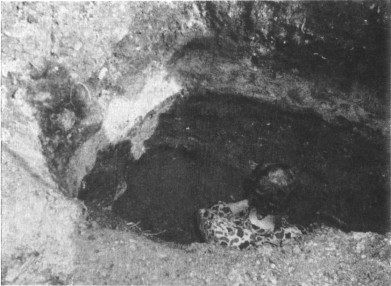
You can barely see the top of one of the digger's head and
shoulders as he
proceeds to scoop out dirt in one of the deep holes.
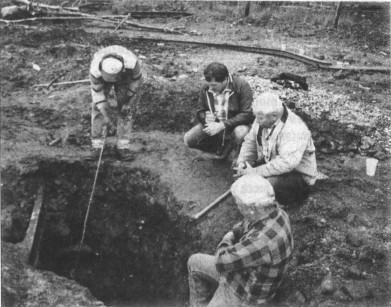
Larry Veneziano (in dark jacket) watches the "old bucket and
rope
trick" used to bring out insulators from the hole.
After two days and nights I returned to the real world, but with
the feeling that I had been a part of a true "happening" in the hobby. How many
of these gems came out? Nobody really knows for sure as the digging may not be
over yet and there are the stashes that people have, but certainly, hundreds of
the various shades of green were dug. A major portion of these were the melts --
those burned, warped, flattened or often fused to others by the fire, but
still specimens with a story to tell. There seem to be only a very few olive
ones known, a relatively few milky aquas and from what the "scuttlebutt"
is, not much over a handful of whole cobalt ones, some of which came out of our
hole -- a truly incredible stroke of fortune.
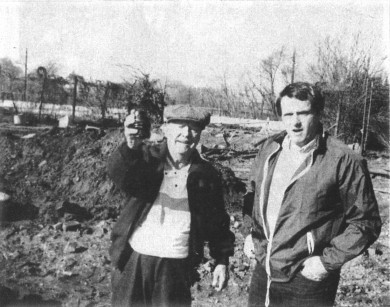
Larry Veneziano (right) and his grandfather who proudly
shows off one of the excavated
Confederate eggs.
In addition to the eggs, there were a few Leffert's ramshorns, some CD 738's
(most in broken or only fair condition, but with rusty wire), pottery eggs,
porcelain teapots (two styles and mostly broken pieces, but a couple of decent
ones), and the front 1/3 of a CD 740 root beer amber embossed "TILLOTSON" on the front crown and "16
B'WAY" on the front skirt. Not a
bad supporting cast!
By now, a larger number of insulator collectors have made
their pilgrimage to the 1990 Mecca of the hobby. Some have returned with pieces they have
dug or purchased and others came away empty. There are an unlimited number of
anecdotes and stories that will be told in the next few months, some good and
some not so good. Along with the excitement of finding these pieces came some
hard feelings and disputes by some, but in spite of it, there is no doubt that
this was one of the greatest finds ever.
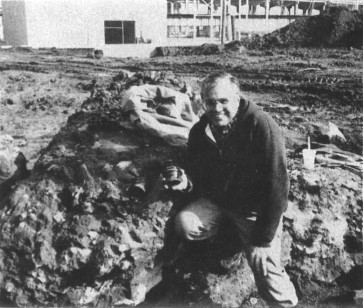
"Marshal Dick" (or maybe we should rename him "Marshal
Dig")
holding a piece from the 1990 Insulator Happening --
The Richmond
"Eggs for the Masses"
The site is now closed to all due to an unpleasant incident involving a
serious injury and may stay closed except to daring and perhaps foolhardy souls.
This incident, fortunately, did not involve any insulator collectors. The final
chapter may not be written as word has it that this area will become part of a
flood control project involving a retaining wall (The Corps of Engineers are currently
working on the other side of the river), thus perhaps more construction and
maybe more surprises for the vigilant.
(Photographs for this article were taken by Larry Veneziano.)
| 